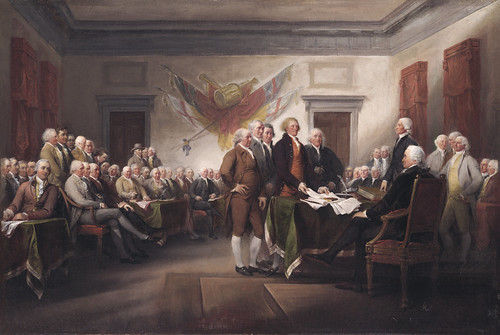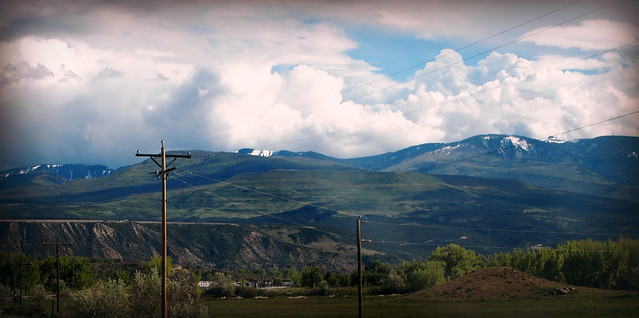Today, considering the day, I think I'll take the time to listen to a recording of one of America's finest symphonies, the First Symphony (in One Movement) of Samuel Barber, which Barber, born in 1910, composed when he was only twenty-six years old. Barber would go on to be a prolific composer, writing in a twentieth-century post-romanticism idiom, of which this is a masterful example. He died in 1981, at age 70.
The piece is formally in one movement, yet, musically, it's tripartite. It opens with an expansively grand theme that sounds like an aural panorama of the American West.
- At the 1:20 mark,
- the statement of a secondary, wistful, theme.
- At the 6:50 mark,
- the orchestra takes off on an easy gallop, but not without some Alan Ladd-like reluctant heroics.
- Around the 9:45 mark,
- John Williams must have been listening when he composed his Imperial Stormtrooper theme for Star Wars.
- Just past eleven minutes in,
- an oboe sings a lover's theme, lovely but elegiac, over strings.
- At about sixteen minutes,
- Barber reworks the opening theme as a passacaglia (think waltz without schmaltz) that grows in urgency.
- Barber brings all to a conclusion beginning at the eighteen minute mark,
- with string and woodwind crescendos building to several terse blasts, brassy and tympanic, like affirmations of what once had been American can-do and American must-do, virtues seemingly quaint in today's America.
Barber's First resounds like the discovery of America's once wide-open spaces: parts dangerous yet promising, parts brooding but without bathos, parts brash while contemplative, the whole expressing those contradictory characters as a unitary strength, something that once had been perceived as quintessentially American.
Today, while listening, I think I'll take the time to drink a fine American beer, pure and true, without artifice...
...and enjoy our Independence Day, while I can.
-----more-----
- I had originally embedded a marvelous performance by Detroit Symphony Orchestra, recorded in 1998, conducted by Neeme Järvi. Järvi emigrated to the United States from Estonia in 1980 and became an American citizen in 1987. He was Music Director of the Detroit Symphony Orchestra from 1990 until 2005. The music label NAXOS had uploaded the performance to YouTube, so I had assumed all was copacetic. Unfortunately, it has since been removed from YouTube. (P.S. I had to adjust the above time cues. This performance by Zinman and the Baltimore Symphony is a minute faster.)
- The 4th of July is celebrated in the USA as Independence Day, commemorating the adoption of the Declaration of Independence on 4 July 1776. However, the painting above, The Declaration of Independence, July 4, 1776, by John Trumbull (1756-1843), actually ...
depicts the moment on 28 June 1776 when the first draft of the Declaration of Independence was presented to the Second Continental Congress. The document stated the principles for which the Revolutionary War was being fought and which remain fundamental to the nation. Less than a week later, on July 4, 1776, the Declaration was officially adopted. It was later signed on August 2, 1776.
In the central group in the painting, Thomas Jefferson, the principal author of the Declaration, is shown placing the document before John Hancock, president of the Congress. With him stand the other members of the committee that created the draft: John Adams, Roger Sherman, Robert Livingston, and Benjamin Franklin. This event occurred in the Pennsylvania State House, now Independence Hall, in Philadelphia, Pennsylvania.
Working in Paris, France, in the 1780s, young John Trumbull began an ambitious series of paintings depicting key moments in American History, including the story of the Declaration of Independence. Thomas Jefferson - then the American minister to France - enthusiastically supported the project and advised, along with John Adams, that all of the Congressional delegates be shown, a total of 56 people! Trumbull spent decades obtaining accurate likenesses, making portraits from life of 36 delegates, and copying others from paintings by other artists. Some participants remained elusive - the finished work contains 47 individuals (42 of the 56 signers plus 5 other patriots).
Trumbull later used the image shown here, measuring only 20 x 30 inches, as the basis for a monumental 12 x 18 feet version which today hangs in the rotunda of the U.S. Capitol in Washington D.C.- —Via The Library of Congress.
- For more from YFGF:
- Follow on Twitter: @Cizauskas.
- Like on Facebook: YoursForGoodFermentables.
- Follow on Flickr: Cizauskas.
- Follow on Instagram: @tcizauskas.












No comments:
Post a Comment
Comment here ...